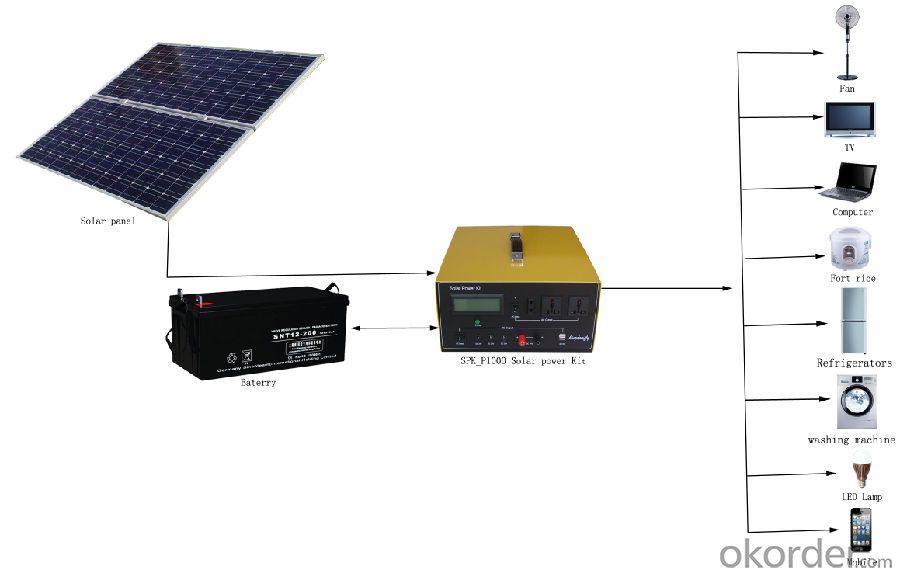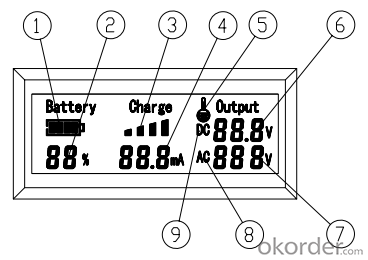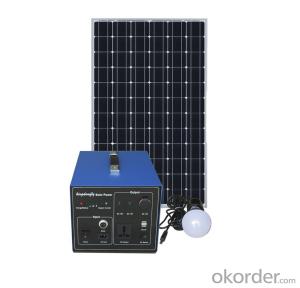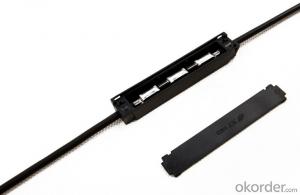Household Solar Power Kit Hot Selling SPK_P1000
- Loading Port:
- China main port
- Payment Terms:
- TT OR LC
- Min Order Qty:
- 3 pc
- Supply Capability:
- 10000 pc/month
OKorder Service Pledge
OKorder Financial Service
You Might Also Like
Main Information
KDF SPK_P1000 This product is high performance,family used portable solar power system,which can receive energy and store it in battery outside connected to SPK by solar energy on sunny day,and supplies electric power for varies appliances such as electric fan,lighting lamps, television, portable computer etc.It can supply power for both DC and AC electric application .It’s very helpful and useful for home electric supply.

Features:
◆ Battery puts outside connected to the SPK for user to choose battery in recommended range, and easily to exchange battery.
◆ Both DC and AC output
◆ Solar Feedback Circuit Protection
◆ Output Short-circuit Protection
◆ Solar「+」「-」anti-access protection
◆ Output「+」「-」anti-access protection
◆ Over Charged Protection
◆ Over Discharged Protection
◆ Over Load Protection
◆ Over-Temperature Protection
Technical parameters
Specification | Value/Material | |
Item No. KDF | SPK_P1000 | |
Solar Recommended | Specification | Poly silicon |
Working Voltage/Power | 36V/80W~500W | |
Battery Recommended | Rated Voltage/Capacity | 24V50AH~200AH |
Cycle Number | 80% Deep Cycle Number:500 70% Cycle Number:800 | |
Working Temperature | Short Period(one Month):-20~50℃Long Period(Six Months):-10~45℃ | |
Charging Controller | Operating Voltage | 24V |
Input Voltage | 34.6V~42V | |
Input current | MAX:20A | |
Power Consumption | MAX: 15mA | |
Low Voltage Disconnect(LVD) | 21.6V | |
Low Voltage Reconnect(LVR) | 24.6V | |
High Voltage Discharge( HVC) | 29.2V | |
High Voltage Recharge(HVR) | 27.6V | |
Temperature Protection | 60℃ | |
DC Output | DC output & Application | USB 5V2A |
DC output & Application | DC 24V | |
AC Output | Output Wave | Pure sine wave |
Input Voltage | 22V~30V | |
Output Voltage | 220V±10% | |
Output Frequency | 60Hz±2Hz/50Hz±2Hz | |
Rated Output Power | 1000W | |
Maximum VA | 2000VA | |
Maximum Efficiency | 88% | |
Temperature | 0-40℃ | |
Over Temperature | 60℃~70℃ | |
Low Voltage Alarm | 22V | |
Low Voltage Shut off | 21V | |
High Voltage Shut off | 30V | |
Package | Set size | 350*449*227mm |
Set N·W | 7.2kg | |
Set N·W | 5.2kg | |
LCD_Display

No. | Name | Function |
1 | Battery Icon | To show the Volume of the Battery |
2 | Date of % | To show the percent of the Battery |
3 | Charging Icon | To show the charging condition |
4 | Current | To show the value of charge current |
5 | Temperature Icon | Temperature Alarm |
6 | Date of Voltage | To Show the Value of DC output voltage |
7 | Date of Voltage | To Show the Value of AC output voltage |
8 | AC Icon | AC output |
9 | DC Icon | DC output |
- Q:Can solar energy systems be used for desalination?
- Yes, solar energy systems can be used for desalination. Solar desalination involves using solar energy to power the desalination process, typically through either solar thermal or solar photovoltaic technologies. This renewable energy source can be harnessed to heat water or generate electricity, which can then be utilized to remove salt and other impurities from seawater or brackish water, making it suitable for drinking or agricultural purposes. Solar desalination offers a sustainable and environmentally friendly solution to address water scarcity issues in regions with abundant sunlight.
- Q:How do solar energy systems contribute to reducing reliance on fossil fuels?
- Solar energy systems contribute to reducing reliance on fossil fuels by harnessing energy from the sun, which is a renewable and abundant source of power. Unlike fossil fuels, solar energy does not produce harmful greenhouse gas emissions or contribute to air pollution. By utilizing solar energy systems, we can decrease our dependence on non-renewable fossil fuels, mitigate climate change, and create a more sustainable and eco-friendly energy future.
- Q:How does the efficiency of solar panels vary across different installation locations?
- The efficiency of solar panels varies across different installation locations due to various factors such as the amount of sunlight received, the angle and orientation of the panels, shading, temperature, and local weather conditions.
- Q:Can solar energy systems be used for powering aquaculture systems?
- Aquaculture systems can indeed be powered by solar energy. Solar power is a sustainable and renewable source of energy that can be utilized to generate electricity. This electricity can then be employed to operate different components of aquaculture systems, including water pumps, aerators, heaters, and lighting. The utilization of solar energy in aquaculture systems presents several advantages. Firstly, it decreases dependence on finite traditional fossil fuels, which contribute to both environmental pollution and climate change. By adopting solar power, aquaculture systems can significantly decrease their carbon footprint and contribute to a cleaner and more environmentally friendly energy future. Secondly, solar energy is abundantly available in numerous regions worldwide. By harnessing the sun's power, aquaculture systems can function independently of the electricity grid, benefiting remote areas that can now engage in sustainable aquaculture practices. Thirdly, solar energy systems offer long-term cost savings. Although the initial setup and installation costs may be higher compared to conventional energy sources, solar energy systems have significantly lower operational expenses. Once the system is installed, solar power is essentially free, and maintenance costs are minimal. This can result in substantial savings over time, making solar-powered aquaculture systems a financially viable choice. Lastly, solar energy systems can be integrated with other renewable energy technologies, such as battery storage systems. This enables surplus solar energy to be stored and utilized during periods of low sunlight, ensuring a consistent and reliable power supply for aquaculture systems. In conclusion, solar energy systems are an effective means of powering aquaculture systems, offering numerous benefits including environmental sustainability, energy independence, cost savings, and integration with other renewable energy technologies.
- Q:How do solar energy systems impact roof maintenance and repairs?
- Solar energy systems can have both positive and negative impacts on roof maintenance and repairs. On the positive side, solar panels can provide an added layer of protection to the roof surface, shielding it from harsh weather conditions and UV radiation. This can help extend the lifespan of the roof, reducing the need for frequent repairs or replacements. Additionally, solar panels can prevent debris from accumulating on the roof, reducing the risk of damage caused by fallen leaves, branches, or other objects. However, there are also some considerations when it comes to roof maintenance and repairs with solar energy systems. Installing solar panels generally requires drilling holes into the roof to secure the mounting brackets, which can potentially lead to leaks if not properly sealed. Therefore, it is crucial to work with experienced and qualified installers who understand the importance of proper sealing and waterproofing. Another factor to consider is access to the roof. Solar panels cover a significant portion of the roof surface, making it more difficult to access and inspect the roof. Regular roof maintenance tasks, such as cleaning gutters, removing debris, or inspecting for damage, may require additional effort and specialized equipment when solar panels are present. In terms of repairs, solar panels can complicate the process. If a repair is required on the roof, the solar panels may need to be temporarily removed to access the damaged area. This can add time and cost to the repair process. Additionally, it is important to coordinate with the solar panel manufacturer or installer to ensure that any repairs are done in a way that does not void the warranty or affect the performance of the solar system. In summary, solar energy systems can have a positive impact on roof maintenance by providing added protection and reducing the risk of damage. However, it is important to work with experienced installers, ensure proper sealing, and consider the impact on access and repairs when installing solar panels.
- Q:How do solar energy systems impact the reliability of electricity supply?
- Solar energy systems have a positive impact on the reliability of electricity supply. By harnessing the sun's energy, solar power systems generate electricity that is clean, renewable, and abundant. This reduces our reliance on traditional fossil fuel-based power generation, which is susceptible to price volatility and supply disruptions. One of the key advantages of solar energy is its distributed nature. Solar panels can be installed on rooftops or in small-scale installations throughout a community, thus creating a decentralized electricity generation model. This distributed generation approach helps to mitigate the risks of large-scale power outages caused by natural disasters, equipment failures, or grid disturbances. In the event of a local blackout or grid failure, solar energy systems can continue to supply electricity to homes, businesses, and critical infrastructure, ensuring a more reliable supply of power. Furthermore, solar power systems can contribute to grid stability and reliability by reducing peak demand on the electricity grid. Solar energy production typically aligns with peak demand periods, such as hot summer afternoons when air conditioning usage is high. By generating electricity during these peak periods, solar systems help to alleviate strain on the grid, reducing the likelihood of blackouts or voltage fluctuations. Additionally, solar energy systems can be combined with energy storage technologies, such as batteries, to provide backup power during periods of low sunlight or grid outages. These energy storage solutions enable excess solar energy to be stored and used when needed, further enhancing the reliability and resilience of electricity supply. In summary, solar energy systems positively impact the reliability of electricity supply by offering a decentralized and distributed generation model, reducing strain on the grid during peak demand periods, and providing backup power through energy storage solutions. By diversifying our energy sources and embracing solar power, we can create a more resilient and reliable electricity supply system.
- Q:Can solar energy systems be used in areas with high levels of dust?
- Solar energy systems can indeed be utilized in areas abundant with dust. Although the efficiency of solar panels may be compromised by dust, electricity generation from sunlight remains feasible. Consistent cleaning and upkeep of the panels can alleviate the influence of dust on their functionality. Moreover, progress in solar panel technology, including the integration of anti-soiling coatings and self-cleaning mechanisms, has simplified the task of preserving their efficiency in dusty surroundings. However, it is crucial to acknowledge that the efficacy of solar energy systems in dusty regions may fluctuate based on the intensity and nature of the dust at hand.
- Q:What is the average lifespan of a solar energy system?
- The average lifespan of a solar energy system is typically around 25 to 30 years.
- Q:Are there any disadvantages to installing a solar energy system?
- Yes, there are a few disadvantages to installing a solar energy system. Some of the main drawbacks include the high upfront cost of installation, the need for sufficient sunlight to generate optimal power, and the requirement for ample space to accommodate the solar panels. Additionally, solar energy systems can be less efficient during cloudy or rainy periods, and their production may not align with peak energy demands. Finally, the maintenance and occasional replacement of components can be costly and time-consuming. Despite these disadvantages, the long-term benefits and environmental advantages of solar energy make it an increasingly popular and viable option for many households and businesses.
- Q:Can solar energy systems be used in areas with limited access to solar energy consultants?
- Yes, solar energy systems can still be used in areas with limited access to solar energy consultants. While the guidance of a consultant can be helpful in designing and implementing an efficient solar energy system, there are plenty of resources available online, including step-by-step guides, tutorials, and calculators, that can assist individuals in setting up their own solar energy systems. Additionally, many solar equipment manufacturers provide technical support and assistance to customers even in remote areas. With the right research, resources, and support, individuals can successfully install and maintain solar energy systems without direct access to consultants.
1. Manufacturer Overview |
|
|---|---|
| Location | |
| Year Established | |
| Annual Output Value | |
| Main Markets | |
| Company Certifications | |
2. Manufacturer Certificates |
|
|---|---|
| a) Certification Name | |
| Range | |
| Reference | |
| Validity Period | |
3. Manufacturer Capability |
|
|---|---|
| a)Trade Capacity | |
| Nearest Port | |
| Export Percentage | |
| No.of Employees in Trade Department | |
| Language Spoken: | |
| b)Factory Information | |
| Factory Size: | |
| No. of Production Lines | |
| Contract Manufacturing | |
| Product Price Range | |
Send your message to us
Household Solar Power Kit Hot Selling SPK_P1000
- Loading Port:
- China main port
- Payment Terms:
- TT OR LC
- Min Order Qty:
- 3 pc
- Supply Capability:
- 10000 pc/month
OKorder Service Pledge
OKorder Financial Service
Similar products
New products
Hot products
Hot Searches
Related keywords






























